Different types of tax disc holder.
In the grand scheme of things, choosing a tax disc holder to suit the age of an old car isn't the most important concern in the world. However, anyone who say has a period-style disc created for their vehicle, might want to hold it in something of a suitable period. This page will hopefully shed light on the types of holder that were oft-encountered at different times during the 20th Century.
|
Background to the "tax disc".
The disc itself was introduced following a shake-up of vehicle taxation in 1920. Since 1910, the level of tax owed had been based on the HP, or "horsepower", rating of the car in question. This wasn't the brake horse-power (bhp) figure for an engine, but a formula dreamt up by the RAC, based on the surface area of an engine's piston. This favoured cars with long-stroke, small-bore engines, which was a feature often found in British cars, and which put many imported vehicles - notably those from America - at a disadvantage, as they tended to have large-bore, short-stroke motors. As it was a legal requirement to display one's disc on the car once introduced in 1921, so too arose the need to have something to display it in.
|
Pre-war tax disc holders.
Typically cars of the vintage, pre-1931, era made use of circular holders that incorporated a screw-on rim, and clear glass lens. These were typically produced in brass, often nickel-plated, although chrome would also become an option, and were often screwed directly to the car's bodywork. Some cars, such as the Austin 7 Ulster, had just such a holder fitted to the nearside scuttle by the factory. Given that many cars of the 1920s were open-top, such a holder would offer a secure method of attaching the disc with no risk of it blowing away in the breeze.
|
|
During the 1930s, more and more drivers were opting for enclosed saloon cars, rather than tourers, and because of this, accessory producers dreamt up new types of holder that could be affixed to the inside of a car's windscreen. The image shown below contains an assortment of types that were on sale in the mid/late 1930s. As a result, any of these would be appropriate in a restored pre-war car in the UK today.
|
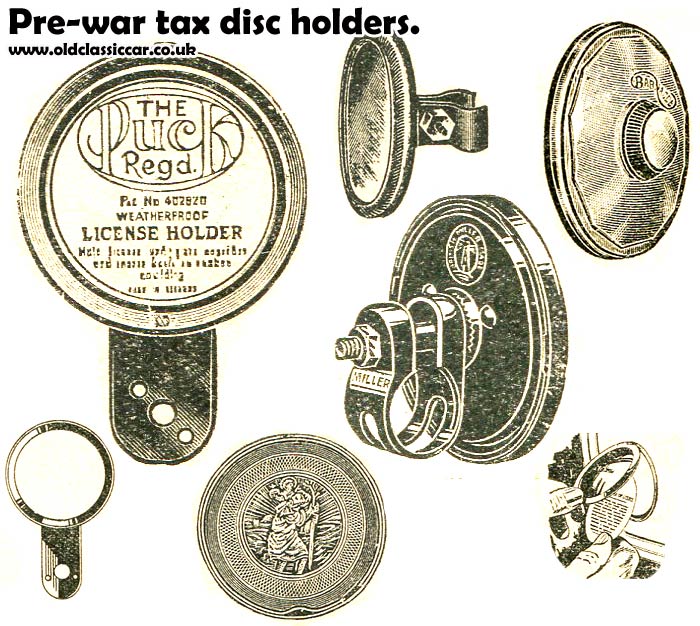
|
|
The Puck for example, was suited to either tourers or motorcycles, and featured a glass lens encased by a rubber surround. To its right is
a version designed to be attached to a tourer's windscreen frame, while to the right of that is an example of the Barnacle suction-type holder, a variant that would be on sale right into the 1970s. In 1937, the date of these images, the Barnacle was available in mahogany, walnut or black colour. A number of different suction-affixed accessories would be sold under the Barnacle name, including for example ash trays and rear view mirrors. The Barnacle Pipe Smoker's Ashtray, which incorporated a holder for one's pipe, may be found on this page at OCC, within the accessories and gadgets section.
|
|
The Miller was more suited to motorcycles, although could in some instances be fitted to cars, or commercial vehicles with suitably-sized door mirror arms. Also shown is an example of holder where the "face" would be stuck to the screen, and the rear bakelite holder (in which the disc was placed) attached to it and held in place with a sprung wire clip. The example shown, with a St. Christopher design on it, was called the Nustickon. The example at the bottom right is by Stadium, and also incorporates one piece stuck to the screen, and a lift-up back into which the disc is placed.
|
Commercial vehicles.
The needs of commercial vehicle operators were slightly different to those of the private motorist. Commercial vehicles also had to display a "C" (Commercial) disc alongside their Road Fund Licence disc. Because of this, dual disc holders were offered. Coaches and buses, which displayed three discs in all, could also be catered for, as the following illustration from the late 1940s demonstrates. That on the left is by Desmo, while the other two are by Wingard.
|

|
Late 1940s and early 1950s.
The following examples were found in catalogues dating to 1948, and another from some time in the early 1950s. By now, stick-on holders were coming onto the market, the example shown below called the Zell-Autofix. Reflecting the changing designs of car that were either on sale, or lined up to
go on sale, is a new type of Barnacle - the "CurveMaster" - again a suction type, suitable for use in a car with a curved screen, something that
was becoming a feature on certain models at the time. The CurveMaster was available in hammer finish, brown, green, blue, silver or bronze. A
plain chrome type was also offered, and is shown alongside it. Two types of Wingard design are also represented, costing either 4s 8d (top) or 2s 8d (bottom).
|
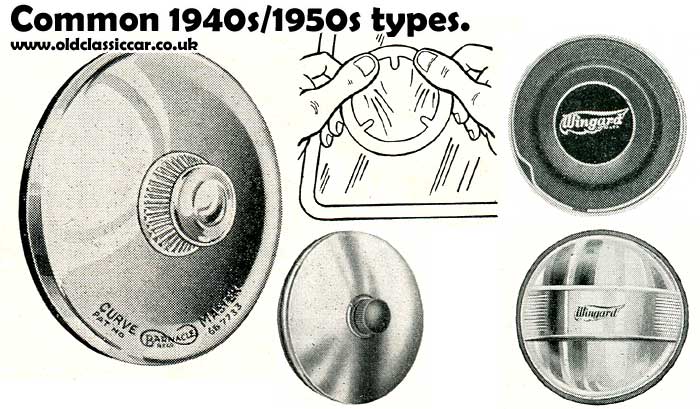
|
More 1950s types.
The early/mid 1950s catalogue also presents some alternative designs. These include the Desmo "Hold Fast", which again features an adhesive section that bonds to the screen, and a removable back piece held on by a clip (similar to the pre-war Nustickon). Available in either black- or walnut-coloured plastic was the Caxton. This could either be ordered in a plain design, or else emblazoned with a trader's details. Car sales companies were by now looking at different ways of advertising their businesses, and distributing customised tax disc holders, keyrings and other free giveaways were all part of their marketing strategies. An example of the Caxton type incorporating a company's details is shown, as is an alternative version from Romac, another once-popular accessories brand.
|
|
To check out the style of tax discs being issued at this time, please see the 1950s tax discs page, where there are scans of discs ranging from 1950 through to 1959.
|
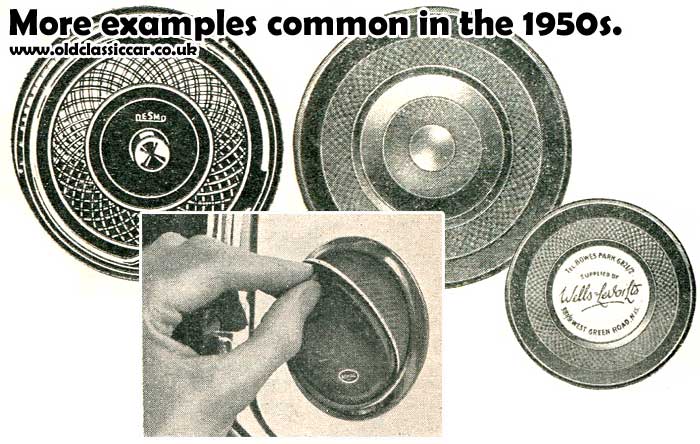
|
Holders that feature car dealers on them.
Perhaps the most commonly-found examples of holders which feature supplying dealer information on them nowadays, are the Barnacle suction types. Here are three that I've found over the years, of the many hundreds no doubt that were produced in the 1950s.
|
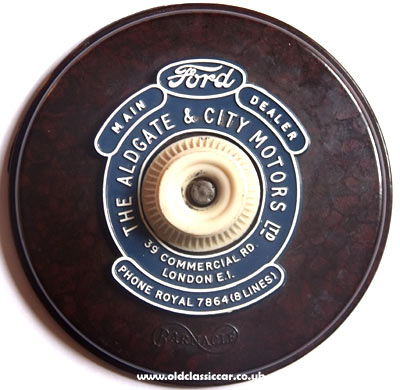
|
Smart bakelite example from the early 1950s, issued with a new Ford sold at The Aldgate & City Motors Ltd, 39 Commercial Road in London.
|
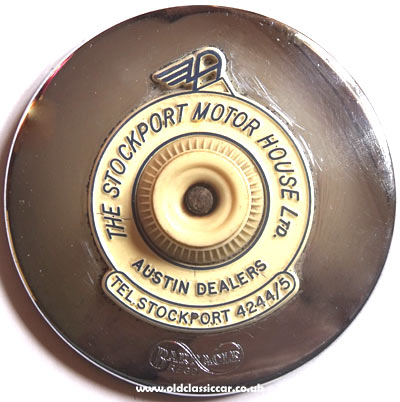
|
A chrome-plated Barnacle holder now, issued by The Stockport Motor House Ltd, Austin Dealers. If I remember correctly, SMH was located in the showrooms on the A6 that pre-war were used to sell Standard motor-cars, and in more recent times by Hollingdrakes to sell new Jaguars. Which car this holder was original used on I don't know, quite possibly one of the "county" Austins, such as the Devon, Somerset, Hampshire or Hereford.
|
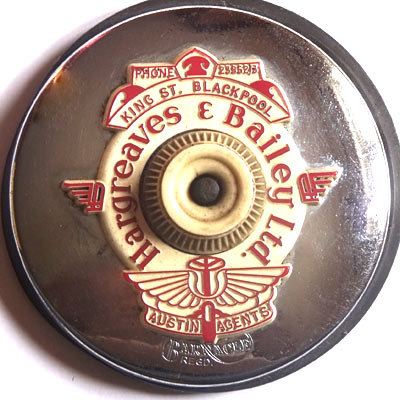
|
Another example of chrome Barnacle, and also for an Austin dealer. This is for Hargeaves & Bailey Ltd, of King Street in Blackpool. This was a lucky find. Scouring a car boot sale some years ago, I found this in the bottom of an old toolbox, covered in thick gloopy oil with its details impossible to read. A good clean-up saw it restored to usable order, and I had this fitted to the black A40 Devon I ran for a number of years.
|
|
Stick-on holders.
As already mentioned, stick-on holders were beginning to make an appearance after WW2. One type referred to previously is the Zell-Autofix, one of many different makes of self-adhesive holder and virtually identical to those still on sale. A pack of information relating to a chap touring his Bentley around Europe in the early 1960s, also contained a couple of new stick-on holders from Zell-Em Limited, of Blackpool. There's nothing remotely unusual about them, but it shows that in the 1950s and 1960s, there were several different styles on offer.
|
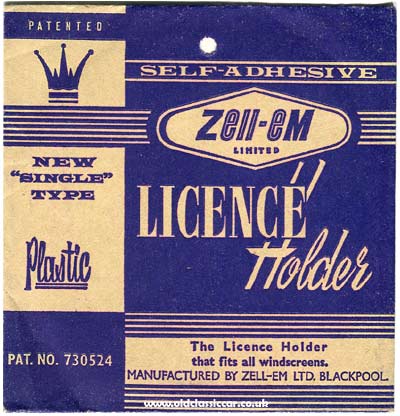
|
Original packet containing a Zell-Em self-adhesive licence holder, dating to the early 1960s most likely.
|
|
The 1960s.
Scanning through accessory catalogues produced in the 1960s, demonstrates how holders were, in the main, becoming simpler, with easily-removable thin plastic holders becoming commonplace. Suction-type versions were still on offer, as the illustrations found in a 1966 catalogue confirm, but the days of attractively-stylised holders were a thing of the past. Dealers would continue to personalise the cheaper plastic holders, but they weren't as nice to look at. The name Puck, which features in pre-war catalogues, continues to have a presence in the 1960s, as does the Nustikon with its St. Christopher badge on its rear cover.
|

|
|
Return to the motoring gadgets, tools & accessories pages at oldclassiccar.
|









